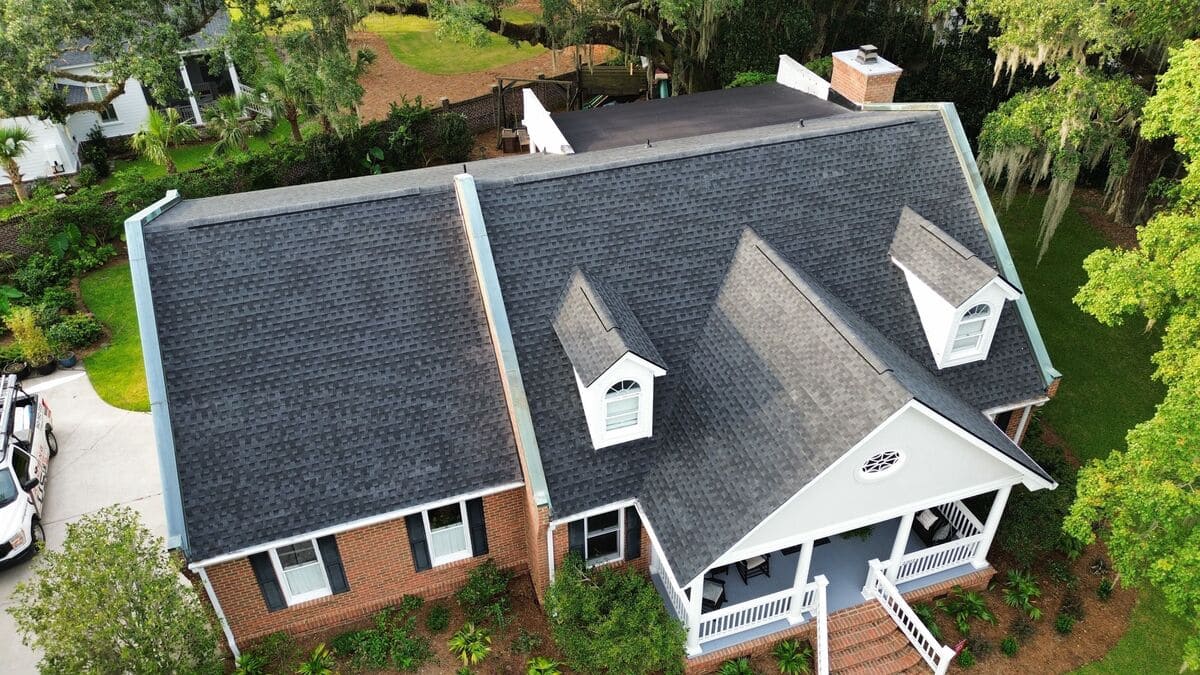When a storm strikes, it can cause damage to your home, including the roof. Dealing with the aftermath can be overwhelming as you navigate insurance claims and find trustworthy contractors for repairs.
This blog from our trusted team at Roofing USA offers a helpful guide to handling post-storm residential roofing work and managing your insurance claims effectively. Keep reading and ensure a smooth recovery process for your home!
Assess the Roof Damage
First, assess the extent of the roof storm damage. This involves carefully inspecting your roof for issues, like missing or damaged shingles, leaks, or other structural damage caused by the storm.
Immediate Steps After Identifying Damage
After a storm, it is crucial to take immediate steps to prevent further damage to your roof and home. Here are some steps you can follow:
-
Inspect for Leaks: Thoroughly check your roof for any signs of leaks or water damage. If you spot any, mark the location for repair.
-
Cover Leaks with Tarps: To temporarily protect your home from water infiltration, cover any identified leaks with sturdy tarps. This will help prevent additional water damage until a professional can assess and fix the issue.
-
Remove Debris and Fallen Branches: Safely clear away any debris, such as fallen branches or leaves, that may have accumulated on your roof during the storm. This will prevent potential damage and blockages in your gutters and downspouts.
-
Assess for Structural Damage: Carefully examine your roof for any visible signs of structural damage, such as loose or missing shingles, sagging areas, or compromised flashing. If you notice any concerns, it is best to consult a professional roofer for further inspection and repair.
-
Document the Damage: Take photos or videos of the storm-related damage to your roof and home. These records will be helpful when filing roofing insurance claims or seeking professional assistance.
Prioritizing immediate action after a storm can help minimize further damage and ensure the safety and integrity of your roof and home.
Identify and Document the Roof Damage
An important step in addressing post-storm roofing work is to identify and thoroughly document the extent of the damage. Take the time to carefully inspect the entire roof, paying close attention to any signs of missing or damaged shingles, cracks, or holes that might have occurred as a result of the storm's impact.
Thoroughly examine the attic for potential leaks or water damage that may have seeped through. To ensure accurate records, capture detailed photographs and diligently document all observed damage.
Hire a Roofing Contractor
If you're not experienced in roofing and lack the necessary knowledge, skills, and tools, it's always better to leave the repair work to qualified professionals. Roofing contractors have the expertise to handle the intricacies of roofing systems, ensuring that the repairs are done effectively and efficiently.
How to Find a Reliable Roofing Contractor
Finding a reliable and experienced roofing contractor can be intimidating, but with the right approach, you can ensure a successful outcome.
Here are the steps to follow:
-
Start by researching local roofing contractors in your area. Look for contractors who specialize in the type of roofing project you need, whether it's repairs, installations, or replacements.
-
Check if the contractor is licensed and insured. A valid license ensures the contractor meets the necessary qualifications and adheres to industry standards.
-
Assess the reputation of the contractor. Read reviews and testimonials from previous clients to get an idea of their quality of work, professionalism, and customer satisfaction. You can find these reviews on their website, social media platforms, or through third-party review websites.
-
Seek referrals from friends, family, or neighbors who have recently had roofing work done. Their personal experiences and recommendations can provide valuable insights into the reliability and performance of the contractor.
-
Schedule consultations with potential contractors. During these meetings, discuss your roofing needs and ask any questions you may have. Pay attention to their communication skills, responsiveness, and willingness to address your concerns.
-
Compare quotes and proposals from multiple contractors. Consider factors such as pricing, materials, warranties, and project timelines. Remember, the cheapest option may not always be the best, so prioritize overall value and quality.
By following these steps, you can navigate through the process of finding a reliable and experienced roofing contractor with confidence.
Their Role in Claims
A skilled and reliable contractor can prove to be invaluable during the insurance claims process. Not only can they provide the necessary documentation and estimates, but they can also offer their expertise and guidance to help navigate through the complexities of the process.
Their attention to detail and thoroughness can contribute to a smooth and successful resolution of the claim, ensuring that you receive the compensation you rightfully deserve.
 What's the Roof Damage Insurance Claims Process?
What's the Roof Damage Insurance Claims Process?
The roof damage insurance claims process begins with notifying your insurance company about the roof damage.
This entails providing an accurate and detailed description of the damage, supplemented with photographs and other supporting documents, such as cost estimates from your roofing contractor.
Filing Steps
Filing an insurance claim can be a complicated and time-consuming process, but it's vital for getting the repair work covered.
To ensure a smooth and successful claim, follow these steps:
-
Contact Your Insurance Company: Contact your insurance provider to notify them about the incident. They will guide you through the process and provide the necessary forms or documentation.
-
Understand Your Coverage: Discuss with your insurance company what is covered under your policy and what isn't. This will help you set realistic expectations and avoid surprises during the claims process.
-
Document the Damages: Take detailed photos or videos of the damaged property or belongings. This visual evidence will support your claim and provide a clear record of the extent of the damage.
-
Provide Necessary Documentation: Fill out the required claim forms provided by your insurance company. Include supporting documents, such as police reports, medical bills, or receipts, to validate your claim.
-
Cooperate with the Insurance Adjuster: An insurance adjuster may be assigned to assess the damage and determine the value of your claim. Cooperate with them, provide all requested information, and be available for inspections or interviews.
-
Keep Records of Communication: Maintain a record of all communication with your insurance company, including dates, times, and the names of the representatives you spoke to. This will help you stay organized and provide reference points if needed.
-
Follow Up On Your Claim: Stay proactive by following up with your insurance company regularly. Inquire about the progress of your claim and ask for updates on any pending matters.
Patience and persistence are essential when filing a roof insurance claim. By following these steps, you can navigate the process more effectively and increase the chances of a successful outcome.
Adjuster's Visit Expectations
To ensure you are fully prepared for an adjuster's visit to assess the damage and estimate the repair work, there are a few key steps to follow.
First, gather all relevant information about the incident, including photographs and written documentation such as police reports or witness statements.
Next, create a detailed inventory of the damaged items and their estimated value.
Additionally, be ready to provide access to the affected areas for the adjuster to conduct a thorough inspection.
By keeping track of all communication and retaining copies of any documentation, you will have a comprehensive record of the process, which can be helpful for any future claims or inquiries.
Financial and Legal Considerations
It's essential to understand the financial and legal considerations involved in post-storm roofing work.
Out-of-Pocket Costs and Financing
Consider your insurance policy and the extent of the damage for out-of-pocket costs. Depending on these factors, expenses can vary and may potentially be high. Thoroughly understand what is covered by your insurance and which ones you'll need to pay for yourself.
To manage these costs, you might want to explore financing options. One possibility is applying for a home improvement loan, which can provide the funds needed to cover the expenses.
Another option is using a credit card, but carefully consider the interest rates and terms associated with it.
Taking the time to weigh your options and make an informed decision can help ensure you choose the best approach for managing these costs effectively.
Understanding Policy and Legal Rights
It is crucial to thoroughly understand your policy and legal rights to avoid any potential conflicts that may arise proactively.
By having a comprehensive understanding of your rights and responsibilities, you can navigate various situations with confidence and make informed decisions that align with your best interests. This knowledge empowers you to protect yourself and ensure a smoother and more seamless experience in any given context.
What Are Some Future Prevention Techniques?
Taking preventive measures is the most effective approach to minimize the risk of potential roof damage.
By regularly inspecting and maintaining your roof, addressing any minor issues promptly, and implementing appropriate weatherproofing measures, you can significantly prolong the lifespan of your roof and ensure its long-term durability.
Storm Resistant Upgrades
To ensure the protection of your roof during severe weather, we recommend investing in storm-resistant upgrades.
Consider incorporating impact-resistant shingles and reliable hurricane straps as these additions can significantly enhance the structural integrity of your roof, safeguarding it from the potential damages caused by extreme weather conditions.
Invest in Regular Maintenance and Inspections
Regular maintenance and inspections are crucial in ensuring the smooth operation of systems and equipment. By conducting regular checks, it becomes possible to identify and address potential issues early on, even before they have the chance to develop into major problems.
This proactive approach allows for timely intervention and preventive measures, resulting in increased efficiency, cost savings, and reduced downtime.
 Handle Post-Storm Repairs With a Columbia, SC Roofing Company
Handle Post-Storm Repairs With a Columbia, SC Roofing Company
Post-storm roofing work can be a challenging task, but with the right steps and preparation, it can be a smooth and successful process. By assessing the damage, hiring a qualified contractor, understanding the insurance claims process, considering financial and legal implications, and investing in future prevention, you can ensure a safe and secured home for you and your family.
If you're looking for a trusted roofing contractor in Columbia, SC, Roofing USA is always available to assist you. We offer 24/7 Emergency Repair Services and are prepared to handle all your post-storm roofing needs.
If you're interested in learning more about how we can help you, contact us today!
Subscribe To Receive The Latest News
Subscribe Here!
There are no related posts
